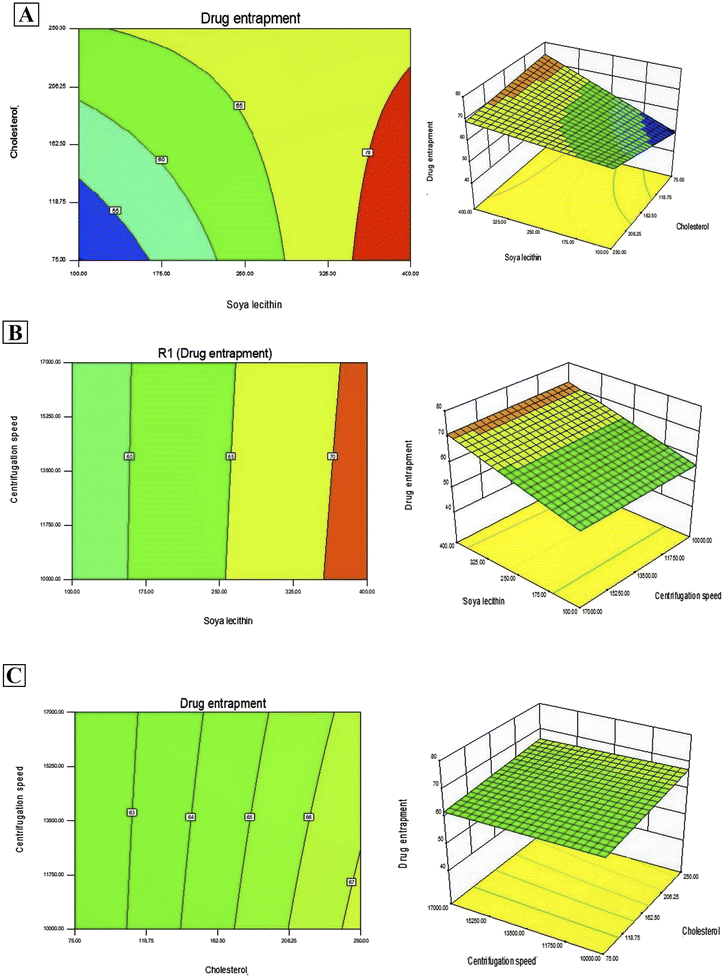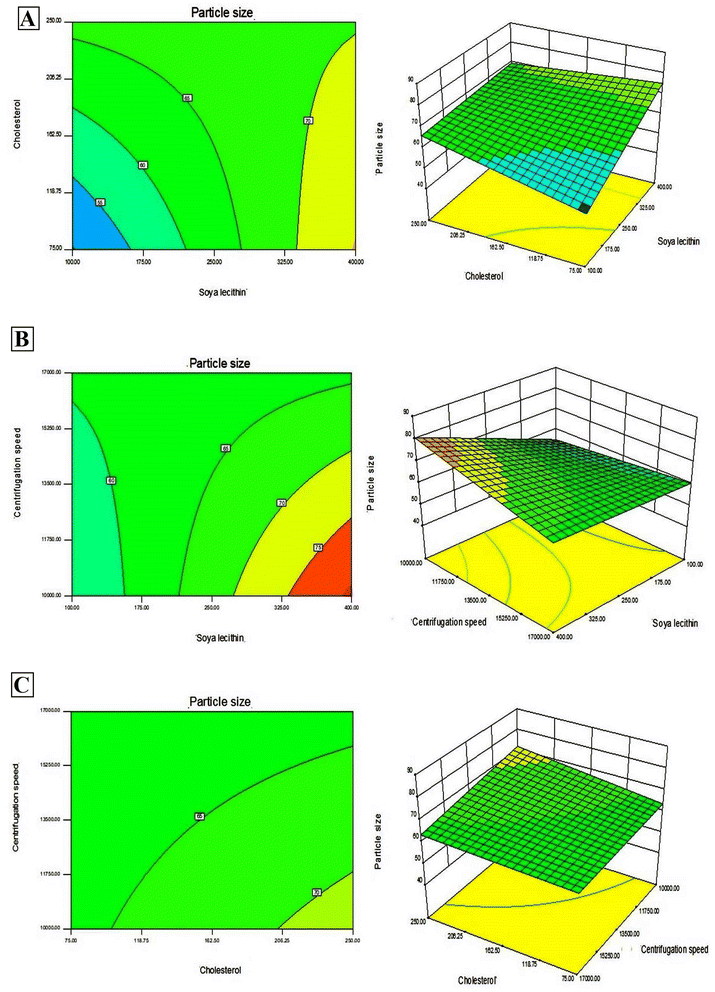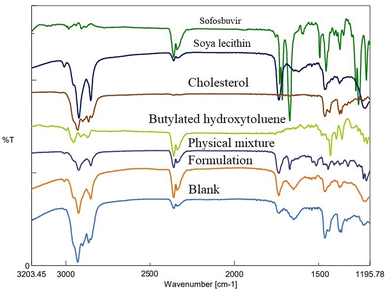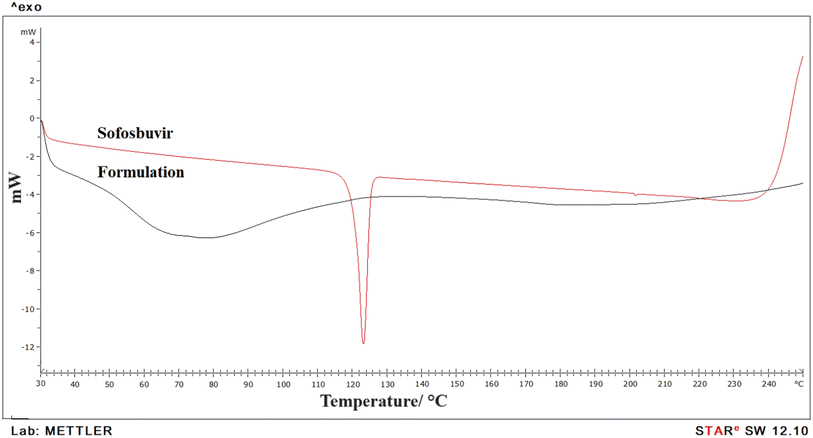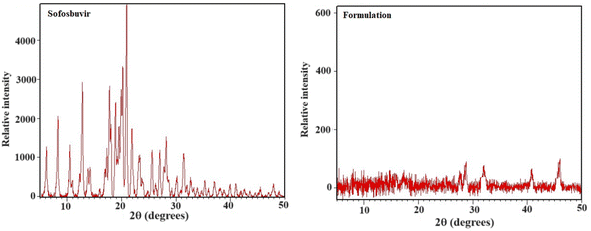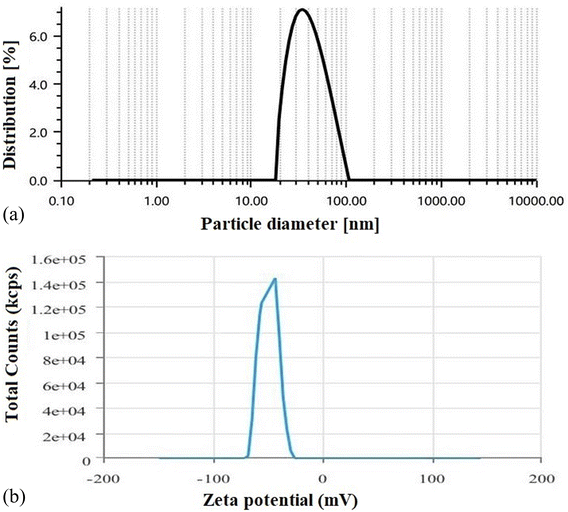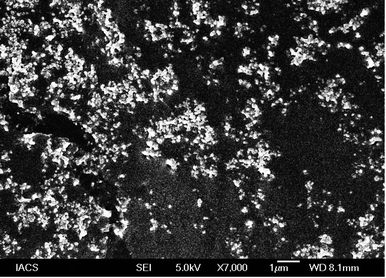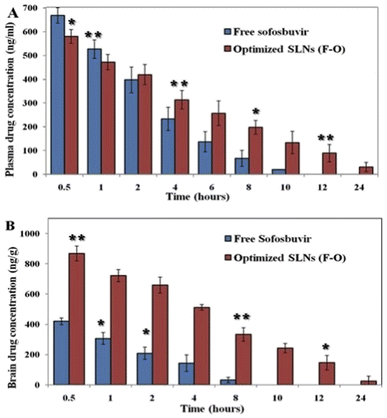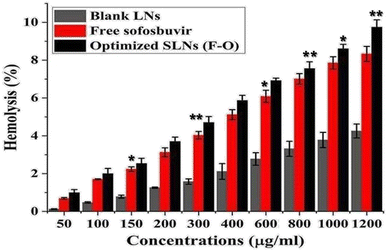 Open Access Article
Open Access ArticleCreative Commons Attribution 3.0 Unported Licence
Conveyance of sofosbuvir through vesicular lipid nanocarriers as an effective strategy for management of viral meningitis
Bhabani Sankar Satapathy,
Pralaya Kumar Sahoo,
Snigdha Pattnaik *,
Amit Kumar Nayak,
Laxmidhar Maharana and
Rudra Narayan Sahoo
*,
Amit Kumar Nayak,
Laxmidhar Maharana and
Rudra Narayan Sahoo
School of Pharmaceutical Sciences, Siksha ‘O’ Anusandhan (Deemed to be University), Kalinga Nagar, Bhubaneswar, Odisha 751003, India. E-mail: snigdhapattnaik@soa.ac.in
First published on 15th November 2023
Abstract
This study aimed to deliver a potential water-soluble antiviral drug (sofosbuvir) through optimized vesicular lipid nanocarriers (LNs) to the rat brain as a novel strategy against viral meningitis. A 23 factorial design approach was established to assess the effect of formulation composition and process variables on the physicochemical properties of the LNs. Sofosbuvir-loaded LNs (SLNs) were developed by lipid layer hydration method utilizing optimized parameters and evaluated for various in vitro characterizations like FTIR, DSC, XRD, FESEM, vesicle size, zeta potential, drug carrying capacity and drug release. Plasma and brain pharmacokinetic (PK) studies were conducted in Sprague-Dawley rats. FTIR data depicted the absence of any major interaction between the drug and the excipients. DSC revealed a sharp endothermic peak for the drug. XRD showed the amorphic nature of the SLNs. Optimized SLNs were spherical as depicted from FESEM with 42.43 nm size, −49.21 mV zeta potential, 8.31% drug loading and sustained drug release in vitro. Plasma/brain PK studies depicted significant improvement in key PK parameters, viz. AUC, AUMC, MRT, and Vd, compared to those for the free drug. A more than 3.5-fold increase in MRT was observed for optimized SLNs (11.2 h) in brain tissue compared to the free drug (3.7 h). Ex vivo hemolysis data confirmed the non-toxic nature of the SLNs to human red blood cells. In silico docking study further confirmed strong interaction between the drug and selected protein 4YXP (herpes simplex) with docking score of −7.5 and 7EWQ protein (mumps virus) with docking score of −7.3. The optimized SLNs may be taken for further in vivo studies to pave the way towards clinical translation.
1. Introduction
Delivery of therapeutic agents to the brain is a perplexing task due to the presence of the blood–brain barrier (BBB).1 Especially, delivery of water-soluble drugs has been most challenging owing to the highly lipophilic nature of the BBB.2 The obstructions imposed by the BBB indeed make the successful treatment of many brain-related diseases difficult, including meningitis.3 However, recent advancements in drug delivery technology have provided some hope of overcoming this challenge. In this context, exploration of nanolipoidal carriers, such as nanoliposomes, solid–lipid nanoparticles, niosomes, and lipid nanoconstructs, has been in the limelight over the past decade to improve the brain delivery of conventional drugs.4 Among various novel carriers, vesicular lipid nanocarriers, commonly referred to as nanoliposomes (LNs), have become a popular strategy for effective delivery of hydrophilic drugs across the BBB to treat brain diseases.5LNs are nano-sized self-assembled vesicles that are constructed from cholesterol and natural phospholipids, enclosing a small aqueous core. In view of their unique architecture, LNs can successfully transport both hydrophilic and hydrophobic entities in their structural scaffold.6 Among various nanocarriers, LNs enjoy special status in the drug delivery arena for their biocompatibility and cell-mimicking nature. Due to their nano-size with high lipophilic nature, LNs are considered potential novel carriers for the delivery of hydrophilic therapeutics to the brain.7 Differences in lipid composition, size, surface charge, and preparation method give LNs with a wide range of properties. Furthermore, the “fluidity” or rigidity of the bilayer and its charge are determined by the choice of bilayer components.8 LNs can engulf hydrophilic/hydrophobic compounds, keep them from disintegrating into one another, and release them at predetermined targets in a sustained manner.9
Sofosbuvir is an established antiviral drug recommended for hepatitis C and other viral diseases.10 However, being a BCS class III drug (low permeability/high solubility), its delivery across the BBB is a big challenge. It has water solubility of 105 mg L−1 at 25 °C. Although the delivery of sofosbuvir through nanocarrier-based platforms has been attempted in some recent investigations, its brain delivery has not been reported so far. In 2022, El-Shafai et al. reported delivery of sofosbuvir through β-cyclodextrin-modified chitosan nanoparticles for treating hepatitis C. Improved drug loading, drug release and cytotoxic activity were observed for sofosbuvir-loaded experimental nanoparticles.11 Another recent work reported cytotoxic testing of sofosbuvir-modified dextran-stabilized silver nanoparticles (AgNP) on the Huh-7 cell line. Data depicted lower cytotoxicity of the sofosbuvir-loaded AgNP on the tested liver cell line than that of the free drug.12 Moreover, sofosbuvir has been reported to protect human brain organoids against COVID-19 infection.13 This study showed that sofosbuvir could effectively protect from neuronal damage and impaired synaptogenesis in SARS-CoV-2 infection, which provides another rationale for use of sofosbuvir in brain disorders.
The aim of the current work was to investigate the potential of optimized LNs to successfully deliver sofosbuvir to the rat brain as a strategy to treat viral meningitis. Sofosbuvir-loaded LNs (SLNs) were developed using a 23 factorial design approach to find the optimum formulation. Optimized SLNs were evaluated for various physicochemical characteristics. Plasma and brain pharmacokinetic (PK) studies were conducted in Sprague-Dawley rats to estimate the drug concentration in the brain and plasma. We also wanted to see the in silico interaction of some crucial meningitis-related virus protein(s) with sofosbuvir. Considering the involvement of herpes simplex and mumps viruses in majority of brain meningitis cases, selected proteins of these two viruses were docked with the drug to establish its rationality for use in meningitis. To the best of our knowledge, encapsulation of sofosbuvir through optimized LNs and its availability in brain tissue is yet to be investigated. Formulation optimization through factorial design, in vitro evaluation, in vivo plasma/brain PK with ex vivo hemolysis data adds uniqueness to the work, which provides necessary insights for furthering research on clinical translation of SLNs to treat viral meningitis.
2. Experimental
2.1 Materials
Cipla Ltd Goa, India provided the drug sofosbuvir as a gift sample. Soy-α-lecithin (SL; Hi-Media Laboratories Pvt. Ltd, Mumbai, India), cholesterol (CHL; E Merck Ltd, Mumbai, India), and butylated hydroxyl toluene (BHT; SRL Chemicals, Mumbai, India) were used. All the other chemicals/reagents used for the study were of analytical grade.2.2 Method of development of experimental SLNs
Experimental SLNs were prepared as per a previously reported method with modifications when required.14,15 Briefly, SL and CHL at the optimized concentrations were taken in 10 ml of chloroform and vigorously shaken. To prevent oxidation, BHT (1% w/v) was also added to the dispersion. With the help of a rotary vacuum evaporator (Aditya Scientific, Mumbai, India), chloroform was removed from the dispersion, leaving a thin lipid layer inside the round-bottom flask. The flask was kept in a desiccator overnight for complete drying of the film. On the second day, 50 ml of phosphate buffer (pH 7.4) was added to the lipid film layer for hydration with the help of a rotary evaporator for 1 h. The dispersion was then sonicated (bath sonicator, Sonix, Vibracell) for 20 min to obtain small unilamellar vesicles. The formulation was stored in the refrigerator followed by centrifugation using a cold centrifuge (Remi centrifuge, R 8C plus, India) at 17![[thin space (1/6-em)]](https://www.rsc.org/images/entities/char_2009.gif) 000 rpm for 30 min. The collected pellets were stored in the refrigerator for 4 h and lyophilized to dry powder form using a lyophilizer (C-GEN BIOTECH -80 Deg laboratory freeze dryer, Pune, India).
000 rpm for 30 min. The collected pellets were stored in the refrigerator for 4 h and lyophilized to dry powder form using a lyophilizer (C-GEN BIOTECH -80 Deg laboratory freeze dryer, Pune, India).
2.3 Process optimization and in vitro characterization of experimental SLNs loaded with sofosbuvir
| Yield% = (actual yield ÷ theoretical yield) × 100 |
![[thin space (1/6-em)]](https://www.rsc.org/images/entities/char_2009.gif) :
:![[thin space (1/6-em)]](https://www.rsc.org/images/entities/char_2009.gif) ethanol (6
ethanol (6![[thin space (1/6-em)]](https://www.rsc.org/images/entities/char_2009.gif) :
:![[thin space (1/6-em)]](https://www.rsc.org/images/entities/char_2009.gif) 4) and vortexed for 30 min. The dispersion was then centrifuged at 17
4) and vortexed for 30 min. The dispersion was then centrifuged at 17![[thin space (1/6-em)]](https://www.rsc.org/images/entities/char_2009.gif) 000 rpm for 30 min.14,19 The supernatant was collected and the absorbance was measured at 280 nm using a UV-visible spectrophotometer (Beckman, Fullerton, CA, USA). The following formula was used to calculate the drug loading (%) and drug loading efficiency (%):
000 rpm for 30 min.14,19 The supernatant was collected and the absorbance was measured at 280 nm using a UV-visible spectrophotometer (Beckman, Fullerton, CA, USA). The following formula was used to calculate the drug loading (%) and drug loading efficiency (%):| Drug loading (%) = (amount of drug in LNs/amount of LNs obtained) × 100 |
| Drug loading efficiency (%) = (practical drug loading/theoretical drug loading) × 100 |
![[thin space (1/6-em)]](https://www.rsc.org/images/entities/char_2009.gif) 000 to 14
000 to 14![[thin space (1/6-em)]](https://www.rsc.org/images/entities/char_2009.gif) 000 Da. The pore size of the dialysis bag was 2.4 nm, which is generally considered ideal for osmosis-related release studies. Lyophilized SLNs (10 mg) were dispersed in PBS and transferred into a dialysis bag. Both sides of the dialysis bag were closed with thread and then it was hung on a stand in a beaker containing 50 ml of PBS (release medium). The whole setup was placed on a magnetic stirrer and stirred at 300 rpm with a magnetic bead. At predetermined time intervals (0.25 h, 0.5 h, 1 h, 2 h, 3 h, 4 h, 5 h, 6 h, 7 h, 8 h, 12 h, and 24 h), samples (3 ml) were withdrawn from the beaker and replaced with fresh release medium. The samples were analysed by UV-visible spectrophotometer at 280 nm, using PBS as the blank. From the standard calibration curve, the concentration of sofosbuvir in the sample was calculated.
000 Da. The pore size of the dialysis bag was 2.4 nm, which is generally considered ideal for osmosis-related release studies. Lyophilized SLNs (10 mg) were dispersed in PBS and transferred into a dialysis bag. Both sides of the dialysis bag were closed with thread and then it was hung on a stand in a beaker containing 50 ml of PBS (release medium). The whole setup was placed on a magnetic stirrer and stirred at 300 rpm with a magnetic bead. At predetermined time intervals (0.25 h, 0.5 h, 1 h, 2 h, 3 h, 4 h, 5 h, 6 h, 7 h, 8 h, 12 h, and 24 h), samples (3 ml) were withdrawn from the beaker and replaced with fresh release medium. The samples were analysed by UV-visible spectrophotometer at 280 nm, using PBS as the blank. From the standard calibration curve, the concentration of sofosbuvir in the sample was calculated.2.4 In vivo studies
![[thin space (1/6-em)]](https://www.rsc.org/images/entities/char_2009.gif) :
:![[thin space (1/6-em)]](https://www.rsc.org/images/entities/char_2009.gif) water, 20
water, 20![[thin space (1/6-em)]](https://www.rsc.org/images/entities/char_2009.gif) :
:![[thin space (1/6-em)]](https://www.rsc.org/images/entities/char_2009.gif) 80 v/v).23 Internal standard (quinine sulfate) solution (50 μl) was added to each sample. About 20 μl of sample was finally injected into the LC-MS/MS system (Agilent 6410, Triple Quad MS-MS, Agilent, USA). Important pharmacokinetic parameters viz. area under the curve (AUC), mean residence time (MRT), area under the first moment curve (AUMC), volume of distribution (Vd), and total clearance (Cl) were determined using the non-compartmental model in Phoenix WinNonlin software (Version 6.0, Pharsight Corporation; Cary, NC).
80 v/v).23 Internal standard (quinine sulfate) solution (50 μl) was added to each sample. About 20 μl of sample was finally injected into the LC-MS/MS system (Agilent 6410, Triple Quad MS-MS, Agilent, USA). Important pharmacokinetic parameters viz. area under the curve (AUC), mean residence time (MRT), area under the first moment curve (AUMC), volume of distribution (Vd), and total clearance (Cl) were determined using the non-compartmental model in Phoenix WinNonlin software (Version 6.0, Pharsight Corporation; Cary, NC).2.5 In silico docking study
The PubChem website was used to obtain the 2D structure of sofosbuvir. The crystal structures of target viral proteins were obtained from the Protein Data Bank (http://www1.rcsb.org/). The molecular docking technique comprised dehydration of all proteins, separation and storage of original ligands, and molecular docking was performed using AutoDockTools-1.5.6.25 PyRx software was used to visualize the components of protein molecular docking.2.6 Statistical analysis
To ensure accuracy and reproducibility, all tests were performed in triplicate. The results are expressed using the average and standard deviation (SD). One-way analysis of variance (ANOVA) was utilized to examine statistical data using the Origin2023b program, followed by Tukey's post hoc test. Differences were considered statistically significant when p < 0.05 was used with 95% confidence.3. Results
3.1 Formulation optimization and in vitro studies
| Code | Soya lecithin (mg) X1 | Cholesterol (mg) X2 | Centrifugation speed (rpm) X3 | Responses | |
|---|---|---|---|---|---|
| DEE (%) | Particle size (nm) | ||||
| a Mean ± S.D.; n = 3. | |||||
| F-1 | 400 (+1) | 250 (+1) | 17![[thin space (1/6-em)]](https://www.rsc.org/images/entities/char_2009.gif) 000 (+1) 000 (+1) |
68.22 | 60.12 |
| F-2 | 400 (+1) | 250 (+1) | 10![[thin space (1/6-em)]](https://www.rsc.org/images/entities/char_2009.gif) 000 (−1) 000 (−1) |
70.12 | 79.32 |
| F-3 | 400 (+1) | 75 (−1) | 10![[thin space (1/6-em)]](https://www.rsc.org/images/entities/char_2009.gif) 000 (−1) 000 (−1) |
74.32 | 82.45 |
| F-4 | 100 (−1) | 75 (−1) | 10![[thin space (1/6-em)]](https://www.rsc.org/images/entities/char_2009.gif) 000 (−1) 000 (−1) |
49.75 | 45.12 |
| F-5 | 400 (+1) | 75 (−1) | 17![[thin space (1/6-em)]](https://www.rsc.org/images/entities/char_2009.gif) 000 (+1) 000 (+1) |
74.32 | 68.22 |
| F-6 | 100 (−1) | 250 (+1) | 17![[thin space (1/6-em)]](https://www.rsc.org/images/entities/char_2009.gif) 000 (+1) 000 (+1) |
64.79 | 67.12 |
| F-7 | 100 (−1) | 75 (−1) | 17![[thin space (1/6-em)]](https://www.rsc.org/images/entities/char_2009.gif) 000 (+1) 000 (+1) |
49.75 | 54.31 |
| F-8 | 100 (−1) | 250 (+1) | 10![[thin space (1/6-em)]](https://www.rsc.org/images/entities/char_2009.gif) 000 (−1) 000 (−1) |
64.59 | 65.21 |
| F-O | 100 | 65 | 10![[thin space (1/6-em)]](https://www.rsc.org/images/entities/char_2009.gif) 000 000 |
Actual values | |
| 51.55 | 42.43 | ||||
| Predicted values | |||||
| 48.63 | 44.29 | ||||
| Error% | 4.81 | 4.20 | |||
The Design-Expert 8.0.6.1 software provided suitable polynomial model equations involving individual main factors and interaction factors. The model equation relating DEE (%) as response became:
| DEE (%) = +30.03 + 0.12 X1 + 0.13 X2 + 1.71 × 10−4 X3 − 3.81 × 10−4 X1X2 − 4.52 × 10−7 X1X3 − 7.76 × 10−7 X2X3 [R2 = 0.9993; F-value = 248.56; p < 0.05] |
The model equation relating vesicle size (nm) as response became:
| Vesicle size (nm) = −5.01 + 0.26 X1 + 0.20 X2 + 2.67 × 10−3 X3 − 4.20 × 10−4 X1X2 − 1.06 × 10−5 X1X3 − 5.00 × 10−6 X2X3 [R2 = 0.9994; F-value = 264.03; p < 0.05] |
The results of ANOVA, as shown in Table 2, indicate that all these models (DEE, %, and vesicle size, nm) are significant (p < 0.05) for all response parameters investigated. Model simplification was carried out by eliminating non-significant terms (p > 0.05) in polynomial equations, giving:
| DEE (%) = +30.03 + 0.12 X1 − 3.81 × 10−4 X1X2 |
| Vesicle size (nm) = −5.01 + 0.26 X1 − 4.20 × 10−4 X1X2 − 1.06 × 10−5 X1X3 |
| Source | Sum of square | d.f.a | Mean square | F-Value | p-Value (prob > F) |
|---|---|---|---|---|---|
| a d.f. = degrees of freedom. | |||||
| DEE (%) | |||||
| Model | 672.96 | 6 | 112.16 | 248.56 | 0.0485 |
| X1 | 424.86 | 1 | 424.86 | 941.52 | 0.0207 |
| X2 | 46.95 | 1 | 46.95 | 104.04 | 0.0622 |
| X3 | 0.45 | 1 | 0.45 | 1.00 | 0.5000 |
| X1X2 | 199.80 | 1 | 199.80 | 442.77 | 0.0302 |
| X1X3 | 0.45 | 1 | 0.45 | 1.00 | 0.5000 |
| X2X3 | 0.45 | 1 | 0.45 | 1.00 | 0.5000 |
![[thin space (1/6-em)]](https://www.rsc.org/images/entities/char_2009.gif) |
|||||
| Vesicle size (nm) | |||||
| Model | 1056.67 | 6 | 176.11 | 264.03 | 0.0471 |
| X1 | 425.59 | 1 | 425.59 | 638.05 | 0.0252 |
| X2 | 58.70 | 1 | 58.70 | 88.00 | 0.0676 |
| X3 | 62.33 | 1 | 62.33 | 93.44 | 0.0656 |
| X1X2 | 243.43 | 1 | 243.43 | 364.96 | 0.0333 |
| X1X3 | 247.87 | 1 | 247.87 | 371.60 | 0.0330 |
| X2X3 | 18.76 | 1 | 18.76 | 28.12 | 0.1187 |
In addition, Design-Expert 8.0.6.1 software generated three-dimensional response surface plots and corresponding two-dimensional contour plots relating various measured responses. These plots were presented to estimate the effects of the independent variables on each response (Fig. 1 and 2). A numerical optimization technique using the desirability approach was employed to develop an optimized formulation (F-O) with the desired response. The desirable ranges of independent variables were restricted to: X1 = 100 mg, X2 = 60 mg and X3 = 10![[thin space (1/6-em)]](https://www.rsc.org/images/entities/char_2009.gif) 000; whereas the desirable ranges of responses were restricted to target: DEE → 70%, and vesicle size → 45 nm. In order to evaluate the optimization capability of models generated according to the results of 23 factorial design, the optimized formulation (F-O SLNs) was prepared using the optimal process variable settings. The optimized SLNs (F-O) were evaluated for DEE (%), and vesicle size (nm). Table 1 lists the results of experiments with predicted responses by the mathematical model and those actually observed. The optimized SLNs (F-O) showed DEE of 51.55%, and vesicle size (nm) of 42.33% with small error values (4.81 and 4.20, respectively).
000; whereas the desirable ranges of responses were restricted to target: DEE → 70%, and vesicle size → 45 nm. In order to evaluate the optimization capability of models generated according to the results of 23 factorial design, the optimized formulation (F-O SLNs) was prepared using the optimal process variable settings. The optimized SLNs (F-O) were evaluated for DEE (%), and vesicle size (nm). Table 1 lists the results of experiments with predicted responses by the mathematical model and those actually observed. The optimized SLNs (F-O) showed DEE of 51.55%, and vesicle size (nm) of 42.33% with small error values (4.81 and 4.20, respectively).
![[double bond, length as m-dash]](https://www.rsc.org/images/entities/char_e001.gif) O stretching). In the physical mixture of drug (sofosbuvir) and excipients, the characteristic peaks of sofosbuvir (e.g., 2923.56 cm−1 related to C–H stretching and 3360.35 cm−1 related to N–H stretching) were also detected, although some minor shifting in the peak intensity was noticed. Similarly, characteristic peaks were noticed at 1514.81 cm−1 (N–O stretching) representing SL, 1735.62 cm−1 (C
O stretching). In the physical mixture of drug (sofosbuvir) and excipients, the characteristic peaks of sofosbuvir (e.g., 2923.56 cm−1 related to C–H stretching and 3360.35 cm−1 related to N–H stretching) were also detected, although some minor shifting in the peak intensity was noticed. Similarly, characteristic peaks were noticed at 1514.81 cm−1 (N–O stretching) representing SL, 1735.62 cm−1 (C![[double bond, length as m-dash]](https://www.rsc.org/images/entities/char_e001.gif) O stretching) representing CHL and at 2953.45 cm−1 (C–H stretching) representing BHT (Fig. 3). The FTIR spectra of the physical mixture clearly showed no new peaks nor any major shifting in peak intensity as compared to the individual component peaks. The results thus overall confirmed the lack of any substantial interaction between the drug and excipients.
O stretching) representing CHL and at 2953.45 cm−1 (C–H stretching) representing BHT (Fig. 3). The FTIR spectra of the physical mixture clearly showed no new peaks nor any major shifting in peak intensity as compared to the individual component peaks. The results thus overall confirmed the lack of any substantial interaction between the drug and excipients.
| Formulation code | Yield, % | Drug loading, % | Loading efficiency, % |
|---|---|---|---|
| Optimized SLNs (F-O) | 68.2% | 7.31 ± 0.33% | 51.55 ± 1.4% |
3.2 In vitro drug release study (dialysis method)
In vitro release study showed the sustained release of sofosbuvir from the optimized SLNs (F-O) (Fig. 8). Although the drug was released relatively faster in the initial hours of the study, which was obvious in most cases, with the passage of time, slower release of the sofosbuvir was observed. Within the reported time period of 24 h, a cumulative 83.29% of sofosbuvir was released from the optimized SLNs (F-O). The sustained sofosbuvir release from the optimized SLNs (F-O) favours their in vivo application.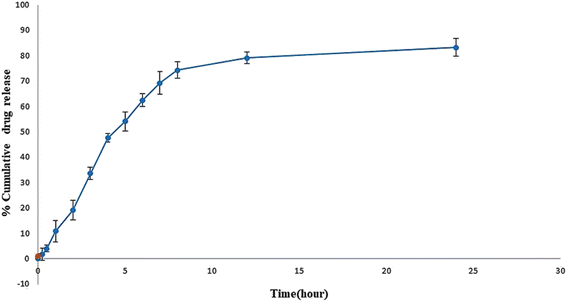 | ||
| Fig. 8 In vitro drug release study of optimized formulation, SLNs (F-O) in phosphate buffer saline, ph 7.4. | ||
| Sl. No. | Release kinetics model | The correlation coefficient of optimized SLNs (F-O) |
|---|---|---|
| 1 | Zero-order model | 0.8242 |
| 2 | First-order model | 0.0265 |
| 3 | Higuchi model | 0.9443 |
| 4 | Hixon–Crowell model | 0.5622 |
| 5 | Korsmeyer peppas model | 0.5303 |
3.3 In vivo pharmacokinetic studies
![[thin space (1/6-em)]](https://www.rsc.org/images/entities/char_2009.gif) 372 ± 1233.5 ng h ml−1 for the optimized SLNs (F-O), whereas it was 6949.7 ± 225.2 ng h ml−1 for pure sofosbuvir. A higher AUC signifies higher bioavailability. Similarly, the MRT (15.4 h) and Vd (0.06 L) of the optimized SLNs (F-O) were also found to be improved significantly as compared to those for free drug administration (5.9 h and 0.02 L). MRT was improved almost three-fold for the optimized SLNs (F-O)-treated group compared to the free drug treatment group. At 24 h, the concentration of sofosbuvir was found to be 28.71 ± 9.22 ng ml−1 for the optimized SLNs (F-O), whereas it was non-detectable for the free sofosbuvir at the same time, confirming the sustained release of the drug from the optimized SLNs (F-O).
372 ± 1233.5 ng h ml−1 for the optimized SLNs (F-O), whereas it was 6949.7 ± 225.2 ng h ml−1 for pure sofosbuvir. A higher AUC signifies higher bioavailability. Similarly, the MRT (15.4 h) and Vd (0.06 L) of the optimized SLNs (F-O) were also found to be improved significantly as compared to those for free drug administration (5.9 h and 0.02 L). MRT was improved almost three-fold for the optimized SLNs (F-O)-treated group compared to the free drug treatment group. At 24 h, the concentration of sofosbuvir was found to be 28.71 ± 9.22 ng ml−1 for the optimized SLNs (F-O), whereas it was non-detectable for the free sofosbuvir at the same time, confirming the sustained release of the drug from the optimized SLNs (F-O).
| PK parameter | Plasmaa | Braina | ||
|---|---|---|---|---|
| Optimized SLNs (F-O) | Free sofosbuvir | Optimized SLNs (F-O) | Free sofosbuvir | |
| a Data show mean ± SD (n = 6). AUC: area under the plasma concentration–time curve; AUMC: area under the first moment curve; Cl: clearance; MRT: mean residence time; Vd: steady state volume of distribution. * Data were significantly different (p < 0.05) where free sofosbuvir and optimized SLNs (F-O) were compared. It was assessed by one-way analysis of variance (ANOVA) through Tukey–Kramer's multiple comparisons test. | ||||
| AUC 0–∞ (ng h ml−1) | 15![[thin space (1/6-em)]](https://www.rsc.org/images/entities/char_2009.gif) 372 ± 1233.5 372 ± 1233.5 |
6949.7 ± 225.2* | 10![[thin space (1/6-em)]](https://www.rsc.org/images/entities/char_2009.gif) 523.6 ± 517.2* 523.6 ± 517.2* |
3141.4 ± 255.7 |
| AUMC0–∞ (ng h2 m−1) | 81![[thin space (1/6-em)]](https://www.rsc.org/images/entities/char_2009.gif) 345 ± 438.6 345 ± 438.6 |
30![[thin space (1/6-em)]](https://www.rsc.org/images/entities/char_2009.gif) 265 ± 2521.8 265 ± 2521.8 |
128 76.8 ± 1895.1 | 4418 ± 247.9* |
| MRT 0–∞ (h) | 15.4 ± 0.51 | 5.9 ± 0.8* | 11.2 ± 5.1* | 3.7 ± 0.11 |
| CI (L h−1) | 0.05 ± 0.1 | 0.81 ± 0.09* | 0.07 ± 0.01 | 0.36 ± 0.44 |
| Vd (L) | 0.06 ± 0.01* | 0.02 ± 0.003 | 0.38 ± 0.07 | 0.05 ± 0.31* |
Brain PK data also showed a similar trend to the plasma PK data in the experimental animal groups (Fig. 9B). The calculated AUC0–∞ of the optimized SLNs (F-O)-treated group was found to be 10![[thin space (1/6-em)]](https://www.rsc.org/images/entities/char_2009.gif) 523.6 ± 517.2 ng h ml−1, whereas the same was 3141.4 ± 255.7 ng h ml−1 for the free sofosbuvir-treated group. Substantial differences were also found between the optimized SLNs (F-O) and the free sofosbuvir-treated groups in terms of the AUMC0–∞, Vd, and MRT values. A higher MRT was observed for the optimized SLNs (F-O) (11.2 h) than the free sofosbuvir (3.7 h) (Table 5). Moreover, the optimized SLNs (F-O) had a higher volume of distribution (0.38 ± 0.07 L) with a lower rate of clearance (0.07 ± 0.01 L h−1) than those of the free drug. Higher AUC, MRT, Vd and lower clearance rate of the optimized SLNs (F-O) signified its higher brain availability than that of free sofosbuvir.
523.6 ± 517.2 ng h ml−1, whereas the same was 3141.4 ± 255.7 ng h ml−1 for the free sofosbuvir-treated group. Substantial differences were also found between the optimized SLNs (F-O) and the free sofosbuvir-treated groups in terms of the AUMC0–∞, Vd, and MRT values. A higher MRT was observed for the optimized SLNs (F-O) (11.2 h) than the free sofosbuvir (3.7 h) (Table 5). Moreover, the optimized SLNs (F-O) had a higher volume of distribution (0.38 ± 0.07 L) with a lower rate of clearance (0.07 ± 0.01 L h−1) than those of the free drug. Higher AUC, MRT, Vd and lower clearance rate of the optimized SLNs (F-O) signified its higher brain availability than that of free sofosbuvir.
3.4 In silico docking analysis
The PubChem database was used to depict the 2D structures of all components of sofosbuvir and the selected proteins (Fig. 11). The top proteins from herpes simplex and mumps viruses were docked with sofosbuvir. Thus, two sets of docking results are shown. Data showed that the tested herpes simplex virus protein (4YXP) has a strong ability to bind with the selected ligand (sofosbuvir) with a docking score of −7.5. Similarly, reasonable binding ability of the drug was observed against mumps viral protein (7EWQ) with docking score of −7.3. In view of the successful ligand–receptor interaction, sofosbuvir has potential to be used against herpes simplex- and mumps-related viral meningitis.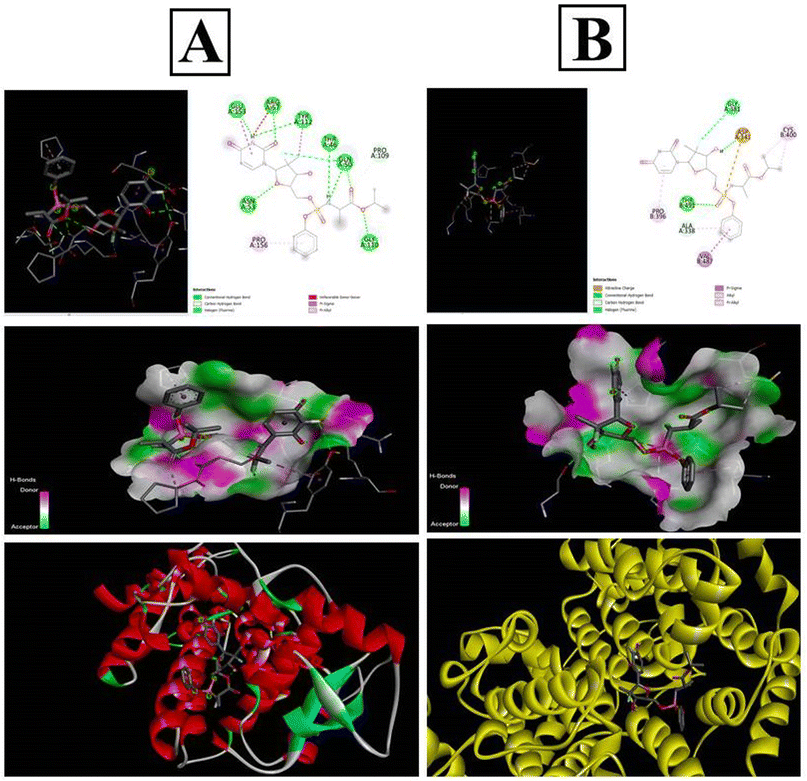 | ||
| Fig. 11 In silico docking analysis of sofosbuvir with the (A) 4YXP (Herpes simplex protein) and (B) 7EWQ (mumps viral protein). Analysis was conducted using AutoDockTools-1.5.6 and PyRx software. | ||
4. Discussion
Transport of hydrophilic therapeutic molecules to the brain through lipophilic nanovesicular carriers has been a recent trend in drug delivery research. Sofosbuvir, a BCS class III drug owing to its hydrophilicity, has a limited role in brain disorders. Thus, delivery of sofosbuvir to rat brain tissue through optimized SLNs (F-O) has been attempted in the work. Various formulations were developed by applying a 23 factorial design approach. Three major formulation factors, viz. amount of SL, amount of CHL and speed of centrifugation, were varied and their corresponding effects on the responses of drug encapsulation efficiency (%) and average vesicle size (nm) were noted. Out of several batches prepared based on factorial design data, F-O (prepared using 100 mg of SL, 60 mg of CHL, and 10![[thin space (1/6-em)]](https://www.rsc.org/images/entities/char_2009.gif) 000 speed of centrifugation) was selected as the optimized formulation with DEE of 51.55%, and vesicle size (nm) of 42.33% with small error values (4.81 and 4.20, respectively). From the 2D contour plots and 3D response surface plots relating to the responses analysed in the present work (drug encapsulation efficiency and average vesicle size), both these responses increased with the increment of the amounts of SL and CHL used to prepare the SLNs. However, no marked effect of centrifugation speed on both the responses was noticed.
000 speed of centrifugation) was selected as the optimized formulation with DEE of 51.55%, and vesicle size (nm) of 42.33% with small error values (4.81 and 4.20, respectively). From the 2D contour plots and 3D response surface plots relating to the responses analysed in the present work (drug encapsulation efficiency and average vesicle size), both these responses increased with the increment of the amounts of SL and CHL used to prepare the SLNs. However, no marked effect of centrifugation speed on both the responses was noticed.
FTIR spectroscopy is used to analyse the interaction of infrared radiation with matter, which can offer important information on molecular structure and interaction of the test material(s). In our case, FTIR data revealed no significant interaction between the drug and the selected lipids/excipients. However, there was a minor physical interaction as some minor shifting in the characteristic peaks was observed from the individual components to the physical mixture/formulation. Such physical interactions play a key role in the successful formation of the vesicular nanostructures. However, the absence of any major shifting in the characteristic peaks of drug/excipient justified well compatibility of sofosbuvir with selected lipids/excipients.
DSC data showed a single sharp endothermic peak for pure sofosbuvir, which was absent in the case of the formulation. It thus indicated successful encapsulation of the drug within nanovesicular structures with reduced crystallinity. Usually, the presence of a sharp melting endotherm signifies crystalline property, whereas a flattened or broader peak without sharpness signifies amorphous nature. Clearly, it was observed that the drug was encapsulated inside the vesicular core with loss of crystallinity. Similar observations in DSC thermograms regarding decreased crystallinity of drugs encapsulated in nanoformulations were also reported by other researchers.26 Further, there was no chemical interaction between sofosbuvir and the selected lipids as no shifting in endothermic peak of drug or appearance of new peaks were detected in the optimized SLNs (F-O).
XRD is a useful tool for identifying the crystalline phases, degree of crystallinity, and texture of polycrystalline samples.27 In the optimized SLNs (F-O), the XRD peaks were not as sharp as the peaks for pure sofosbuvir, which was another clear indication of the slightly amorphous nature of the formulation. Although no such new peaks were detected in the optimized SLNs (F-O), a change in peak height/intensity was observed as compared to the XRD diffractogram for pure sofosbuvir. However, the decreased crystallinity of the drug would not alter its action, rather it would be helpful for improvement of the dissolution profile of the drug encapsulated in the vesicular lipid core. Similar findings related to XRD data were also reported in other studies, where encapsulation of a drug in a nanocarrier core led to decreased sharpness or width/height of the peaks (amorphization).28,29 However, in those studies, there were no reports were related of changes in drug efficacy following amorphization.
FESEM analysis depicted the formation of spherical shaped vesicles within the nano-size range (less than 100 nm) with a smooth surface. The vesicles were mostly homogenous in size range. However, the overall size of the vesicles was found to be in good agreement with the DLS data. Despite the close proximity of the vesicles, there were no signs of bigger lumps in the sample, justifying the suitability of standardized process parameters used for formulation development.
Like FESEM, the PDI is also a significant indicator of the stability, size distribution and homogeneity of a colloidal dispersion system. A low PDI suggests more homogeneous distribution of colloidal vesicles with higher stability. In contrast, a higher PDI score indicates particle aggregation with low suspension stability. The optimized formulation (F-O SLNs) exhibited a PDI of 0.53, which thus suggests that the formed vesicles were relatively uniform in size and spread uniformly throughout the formulation. Zeta potential is another key parameter in predicting the stability of colloidal particles in a dispersion, as it determines the electrostatic repulsion/attraction between particles.22 A zeta potential greater than +30 mV or less than −30 mV usually indicates that particles are stable in colloidal dispersion.14 In our study, the optimized SLNs (F-O) showed a high negative zeta potential (−49.2 mV). This indicates that the formulation would have greater physical stability in suspension form.
The purpose of an in vitro release study is to determine how quickly and to what extent the drug is released from the delivery system under simulated physiological conditions. During the release study period, the optimized SLNs (F-O) released 83.29% of the sofosbuvir. Although initially higher release of sofosbuvir was observed from optimized SLNs (F-O), the overall release pattern clearly depicted sustained release. Further, when the release data was fitted into various kinetic models, the Higuchi model showed the best linearity (R2 = 0.9482), which indicates a non-Fickian drug diffusion pattern and suggests that the release of the sofosbuvir from the vesicular lipid core might follow a diffusion and erosion mechanism.
PK describes the movement pattern of a therapeutic molecule throughout the body, which can be overall stated the actions of the body on the therapeutic molecule. For drugs to be approved by regulatory bodies before clinical use, PK data is crucial. Important PK parameters like AUC, MRT, and Vd have significant meaning in relation to the therapeutic effectiveness and bioavailability of drugs. The area under a plot of drug plasma concentration versus time following administration of a drug is normally referred to as ‘area under the curve’ (AUC). AUC depicts the extent of exposure of a drug inside the body and its rate of clearance. Overall, a higher AUC signifies higher bioavailability. Mean residence time (MRT) is another important PK parameter, which is considered crucial for drugs that are administered intravenously (i.v. bolus/infusion) in a one- or two-compartment system following Michaelis–Menten elimination. Overall, MRT represents the average duration of residence of a drug in the body. Similarly, volume of distribution (Vd), another important PK parameter, serves as an indicator of the extent to which a drug is distributed from plasma throughout the tissues. It is used to estimate the dose of drug required to achieve a steady-state plasma concentration. The higher the Vd, the higher the distribution of the drug in other tissues (extravascular compartment). In turn, Vd is a prime determinant of the half-life of a drug.
Our in vivo PK study clearly depicted improved plasma/brain PK parameters in animals treated with optimized SLNs (F-O) as compared to those treated with free sofosbuvir post i.v. bolus. The plasma drug concentration in the optimized SLNs (F-O)-treated group was higher than that in the free sofosbuvir-treated group after 24 hours. The drug concentration was undetectable in the free drug-treated groups at 24 h, whereas it was 28.71 ng ml−1 in the optimized SLNs (F-O)-treated group. A clear difference in MRT was also observed between the two groups with an almost three-fold increase for the optimized SLNs (F-O)-treated group. Other important parameters, such as AUMC, Vd, and Cl, were also found to be significantly different in the optimized SLNs (F-O) and free sofosbuvir-treated groups, justifying the higher bioavailability and longer residence time of the optimized SLNs (F-O) compared to the free sofosbuvir. A similar observation was noted for the brain PK study. The MRT of the optimized SLNs (F-O) in the brain was increased by more than 3.5 times compared to the MRT of free sofosbuvir. Even at 10 h, the concentration of sofosbuvir was no longer detectable in the free drug-treated group, since it had gone beyond the threshold detection limit of the LC-MS/MS method. However, from the optimized SLNs (F-O) sofosbuvir was detected even at 24 h. Clearly, the data showed that the optimized SLNs (F-O) demonstrated significantly prolonged accumulation in brain tissue. In view of the desired nano-size, highly lipophilic nature and higher negative surface charge, the optimized SLNs (F-O) might successfully bypass the trap of reticuloendothelial cells and could remain in the brain for sufficient period of time.
As blood compatibility is an important criteria for formulations intended for parenteral application, ex vivo hemolysis assay has become a widely accepted method for validating the in vivo application of novel parenteral products. The study depicted negligible hemolysis in rat RBCs treated with the optimized SLNs (F-O)/blank LNs. Thus, the formulation was proved to be blood-compatible, non-toxic and could be safely used for further in vivo studies.
In silico docking study of sofosbuvir with 4YXP (herpes simplex protein) and 7EWQ (mumps viral protein) showed effective binding of the selected proteins with sofosbuvir. The lower the binding energy, the tighter the bond would be. Thus, lower docking score signifies higher binding interaction. In this study, a reasonable docking score of −7.5 for sofosbuvir and 4YXP and −7.3 for sofosbuvir and 7EWQ showed satisfactory molecular interaction of the drug and ligands. The study thus provided desirable information on the rationality of use of sofosbuvir in viral meningitis.
5. Conclusion
This work attempted to improve the brain delivery of a potent water-soluble antiviral drug via an experimentally developed lipid nanocarrier as a futuristic strategy for effective treatment of meningitis. SLNs were successfully developed using 23 factorial design and the results were well correlated with actual data. FTIR/DSC studies showed the compatibility of sofosbuvir with the excipients. The optimized SLNs (F-O) had spherical shape, smooth surface, desirable nano-size, low PDI, and 8.31% loading capacity with sustained release of sofosbuvir in vitro. The optimized SLNs (F-O) exhibited longer MRT and AUC than those of free sofosbuvir, as assessed from PK data. Hemolysis data showed the blood-compatible nature of the optimized SLNs (F-O). Satisfactory molecular interaction of sofosbuvir with herpes simplex and mumps viral proteins provided rationale for the potential application of sofosbuvir in viral meningitis. Further studies are under way to check the in vivo effectiveness of optimized SLNs (F-O) in animal models.Author contributions
Bhabani Sankar Satapathy: conceptualization, draft preparation, data analysis. Pralaya Kumar Sahoo: literature search, material preparation. Snigdha Pattnaik: original draft preparation and editing. Amit Kumar Nayak: critically revised the work. Laxmidhar Maharana: data analysis. Rudra Narayan Sahoo: references arrangement and editing.Conflicts of interest
The authors of the article have no conflicts of interest to declare.Acknowledgements
The authors are very much grateful to Prof. Manoj Ranjan Nayak, President, Siksha ‘O’ Anusandhan for providing necessary facilities and encouragement.References
- W. Zhang, A. Mehta, Z. Tong, L. Esser and N. H. Voelcker, Advanced Science, 2021, 10, 2003937 CrossRef PubMed.
- S. Khaledian, M. Dayani, A. Fatahian, R. Fatahian and F. Martinez, J. Mol. Liq., 2022, 346, 118278 CrossRef CAS.
- R. Khatoon, M. A. Alam and P. K. Sharma, J. Drug Delivery Sci. Technol., 2021, 61, 102098 CrossRef CAS.
- S. Javed, B. Mangla, Y. Almoshari, M. H. Sultan and W. Ahsan, Nanotechnol. Rev., 2022, 1, 1744–1777 CrossRef.
- H. Kaur, V. Kumar, K. Kumar, S. Rathor, P. Kumari and J. Singh, Curr. Pharm. Des., 2016, 19, 2761–2787 CrossRef PubMed.
- K. M. Aguilar-Pérez, J. I. Avilés-Castrillo, D. I. Medina, R. Parra-Saldivar and H. M. Iqbal, Front. Bioeng. Biotechnol., 2020, 8, 579536 CrossRef PubMed.
- M. Dahiya and H. Dureja, Curr. Nanomater., 2018, 2, 62–74 CrossRef.
- P. C. Soema, G. J. Willems, W. Jiskoot, J. P. Amorij and G. F. Kersten, Eur. J. Pharm. Biopharm., 2015, 94, 427–435 CrossRef CAS PubMed.
- B. Mukherjee, L. Mondal, S. Chakraborty, P. Paul, A. Choudhury, S. Bhattacharya and M. C. Hossain, Curr. Pharm. Biotechnol., 2015, 4, 380–391 CrossRef.
- Y. Chugh, R. K. Dhiman, M. Premkumar, S. Prinja, G. Singh Grover and P. Bahuguna, PLoS One, 2019, 8, e0221769 CrossRef PubMed.
- N. M. El-Shafai, M. S. Masoud, M. M. Ibrahim, M. S. Ramadan, G. A. M. Mersal and I. M. El-Mehasseb, Int. J. Biol. Macromol., 2022, 207, 402–413 CrossRef CAS PubMed.
- A. N. Awan, R. Khalid, A. Javed, M. R. Shah and S. A. Ali, Plasmonics, 2023, 3, 1181–1193 CrossRef.
- P. Mesci, A. Macia, A. Saleh, L. Martin-Sancho, X. Yin, C. Snethlage, S. Avansini, S. K. Chanda, and A. Muotri, bioRxiv, 2020, preprint, pp. 2020–2105, arXiv:2020.05.30.125856, DOI:10.1101/2020.05.30.125856.
- B. S. Satapathy, B. Mukherjee, R. Baishya, M. C. Debnath, N. S. Dey and R. Maji, RSC Adv., 2016, 88, 85261–85274 RSC.
- M. Alavi, M. Rai, R. S. Varma, M. Hamidi and M. R. Mozafari, Micro Nano Bio Asp., 2022, 1, 18–29 Search PubMed.
- K. Pramod, C. V. Suneesh, S. Shanavas, S. H. Ansari and J. Ali, J. Anal. Sci. Technol., 2015, 1, 1–4 Search PubMed.
- C. Leyva-Porras, P. Cruz-Alcantar, V. Espinosa-Solís, E. Martínez-Guerra, C. I. Piñón-Balderrama, I. Compean Martínez and M. Z. Saavedra-Leos, Polymers, 2019, 1, 5 CrossRef PubMed.
- A. A. Bunaciu, E. G. UdriŞTioiu and H. Y. Aboul-Enein, Crit. Rev. Anal. Chem., 2015, 4, 289–299 CrossRef PubMed.
- P. Bhatt, R. Lalani, I. Vhora, S. Patil, J. Amrutiya, A. Misra and R. Mashru, Int. J. Pharm., 2018, 1, 95–107 CrossRef PubMed.
- S. A. Karmakar, Recent Trends Mater. Phys. Chem., 2019, 117–159 Search PubMed.
- Y. Zheng, D. J. Cosgrove and G. Ning, Microsc. Microanal., 2017, 5, 1048–1054 CrossRef PubMed.
- B. S. Satapathy, L. A. Kumar, G. Pattnaik and B. Barik, Acta Chim. Slov., 2021, 4, 970–982 CrossRef PubMed.
- L. Mondal, B. Mukherjee, K. Das, S. Bhattacharya, D. Dutta, S. Chakraborty, M. M. Pal, R. H. Gaonkar and M. C. Debnath, Int. J. Nanomed., 2019, 8073–8094 CrossRef CAS PubMed.
- J. Panda, B. S. Satapathy, B. Mandal, R. Sen, B. Mukherjee, R. Sarkar and B. Tudu, J. Microencapsulation, 2021, 38, 36–46 CrossRef CAS PubMed.
- W. Chen, H. Kan, M. Qin, J. Yang and W. Tao, BioMed Res. Int., 2023, 1–13 Search PubMed.
- C. W. Ang, L. Tan, Z. Qu, N. P. West, M. A. Cooper, A. Popat and M. A. Blaskovich, ACS Biomater. Sci. Eng., 2021, 8, 4196–4206 CrossRef PubMed.
- B. S. Satapathy, A. Patel, R. N. Sahoo and S. Mallick, J. Serb. Chem. Soc., 2021, 86, 51–61 CrossRef CAS.
- K. Gou, Y. Wang, X. Guo, Y. Wang, Y. Bian, H. Zhao, Y. Guo, Y. Pang, L. Xie, S. Li and H. Li, Acta Biomater., 2021, 134, 576–592 CrossRef CAS PubMed.
- C. W. Ang, L. Tan, Z. Qu, N. P. West, M. A. Cooper, A. Popat and M. A. Blaskovich, ACS Biomater. Sci. Eng., 2021, 8, 4196–4206 CrossRef PubMed.
| This journal is © The Royal Society of Chemistry 2023 |

